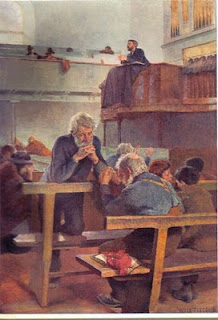Here are some useful links that may help you to find the information you need on the ancestor you are researching:
Tuesday, September 16, 2014
My great ... grandfather (or grand mother ) was a Primitive Methodist
A common question I often get asked is "do you have any details on ... (my relative)?".
Here are some useful links that may help you to find the information you need on the ancestor you are researching:
Here are some useful links that may help you to find the information you need on the ancestor you are researching:
Wednesday, August 13, 2014
The least likely place
In his book Revival, Selwyn Hughes makes this observation. Revival ... begins in the most unlikely places. Pentecost, you remember, began not in the majestic atmosphere of Solomon's Temple, but in an Upper Room. For some reason, God seems to delight in bypassing the places where we might expect revival to break out – in a splendid cathedral or at a large Christian conference – and causes His fire to burst out in a small prayer meeting where only a few are present. In fact, no revival has been an official movement of the Church. This is why revival always astonishes the Church - it flares up where it is least expected.
Have you ever heard of the Primitive Methodist Revival in the 1800s? This began not on the historic sites of former Methodist accomplishments, such as in London or Bristol, but in a tiny hamlet on the hillside of Mow Cop near Stoke-on-Trent. Someone described it as the 'least likely place in which a revival has ever broken out.' And why? Because there were only a few grey, roughly built cottages situated there, inhabited by people with little intellectual ability or learning. The area was bleak, rugged and uninteresting. Nevertheless, this is the place God chose in which to manifest His power and glory. If ever the Church receives a blow to its pride, it is when God breaks forth in revival.
 
|
Revival, Times of Refreshing, pages 63-64 Selwyn Hughes, CWR Publishing, 2004
Friday, July 25, 2014
Primitive Methodists at Prayer

William Holt Yates Titcomb (1858-1930)
The painting shows the interior of Primitive Methodists at Prayer on Fore Street, St Ives. The occasion depicted appears to be a prayer meeting following a summer evening preaching service.
Prayer fuelled the growth of Primitive Methodism. If we are to raise an army it will need those who are committed to pray for the workers in the harvest fields of our schools, Universities, colleges, workplaces and social gatherings across the nation.
Sources
1. http://www.wickersleyweb.co.uk/hist/titcomb.htm
2. http://scotwise.blogspot.com/2005/05/primitive-methodists-by-w-h-y-titcomb.html
3. Primitive Methodism, Geoffrey Milburn, page 79
The painting shows the interior of Primitive Methodists at Prayer on Fore Street, St Ives. The occasion depicted appears to be a prayer meeting following a summer evening preaching service.
Prayer fuelled the growth of Primitive Methodism. If we are to raise an army it will need those who are committed to pray for the workers in the harvest fields of our schools, Universities, colleges, workplaces and social gatherings across the nation.
Sources
1. http://www.wickersleyweb.co.uk/hist/titcomb.htm
2. http://scotwise.blogspot.com/2005/05/primitive-methodists-by-w-h-y-titcomb.html
3. Primitive Methodism, Geoffrey Milburn, page 79
Wednesday, July 2, 2014
The spread of Primitive Methodism 1810 -1850
Following the River Trent (1810-1820)
The missionary pioneers of the Primitive Methodist movement journeyed from town to town, and village to village. In a ten year span from 1810 to 1820 they “missioned” towns and villages following the course of the River Trent, in the English Midlands from Stoke-on-Trent and going east via Nottingham towards the port city of Hull. In each place they formed Methodist societies and in due course they built chapels. The slideshow illustrates the spread of the movement county by county.
1. How does your garden grow?
2. Multiplication by budding
3. Multiplication by offshoots




